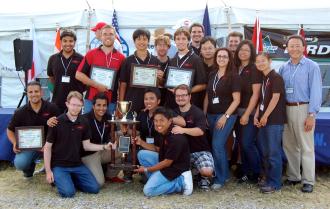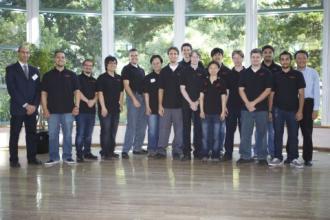CSUN team takes top honors at national Intelligent Ground Vehicle competition
(June 2011)

We are delighted with the performance of our outstanding Intelligent Ground Vehicle Team which took first place in the national competition at Oakland University in June 2011. The CSUN IGV team consisted of:
Mohammed Alhadlaq, Omar Alshahrani, Pei-chun Chen, Rodney Cheong Ye Yeu, Mike Cowhick, Alfie Gil, Amiel Hartman, Manuel Hernandez, Joseph Horvath, Rome Kenmepol, Nicholas Robert Keyawa (Proj Mgr), Andrew Lee, Garrett Leonard, Ara Mekhtarian, Jimmy Mohan, David Prince, Michael Staudenmeir, Steve Valadez, and Po-Jen Wang
The annual competition is sponsored by the Association for Unmanned Vehicle Systems International (AUVSI). There were 48 robots in this year’s competition including nine international entries from Canada, China, India, Jordan and the United Arab Emirates. This is the first time in the history of the 19 year old competition that a team from the West Coast has won first place and the grand award.
Congratulations to Prof. C. T. Lin and the team for your terrific accomplishment. We are really proud of you!
For a detailed account including a video from the event please see: https://www.auvsi.org/auvsi/news
S. K. Ramesh, Ph.D.
Dean
California State Northridge Takes Top Honors at IGVC
By: Danielle Lucey, June 7, 2011
 California State Northridge and its robot Red Raven placed first in the 19th annual Intelligent Ground Vehicle Competition, held on the campus of Oakland University this week.
California State Northridge and its robot Red Raven placed first in the 19th annual Intelligent Ground Vehicle Competition, held on the campus of Oakland University this week.
The team placed in three of the competition’s four categories, the autonomous, navigation and design challenges, leaving only the JAUS challenge untouched.
The team relied on LabView 2009 to control its algorithms and had a dynamic frame inspired by the Mars Rovers, which allows it to maintain stability by keeping its center of gravity very low.
The Red Raven, also called the Red Robotic Autonomous Vehicle, had all electronics centralized to one circuit board. A major obstacle the team had to overcome was the distortion provided by their wide angle lens, which was distorting how their mapping seemed to the robot. The robot this year was brand new, but student team leader Nicholas Keyawa says they’ll likely built upon the same robot next year.
The autonomous competition this year required a 1 mph minimum speed for robots, which proved to not be a problem for the 4.5 mph top speed on grass for Red Raven.
The large team consisted of 18 people, mostly seniors. About 15 were electrical and mechanical engineering students, and three student volunteers that traveled with the team.
“I love my team, I love my college,” said Keyawa after the win. “This has been the greatest experience of my life.”
